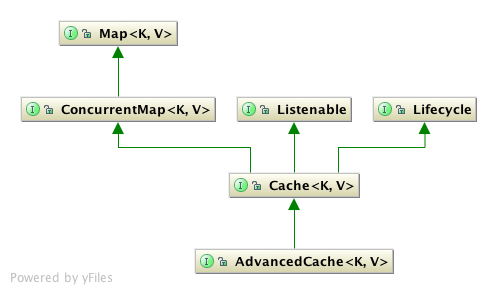Note: For simple usage, using the Cache API should be no different from using the JDK Map API, and hence migrating from simple in-memory caches based on a Map to Infinispan's Cache should be trivial.
The Cache interface
Infinispan exposes a simple, JSR-107 compliant Cache interface.

The Cache interface exposes simple methods for adding, retrieving and removing entries, including atomic mechanisms exposed by the JDK's ConcurrentMap interface. Based on the cache mode used, invoking these methods will trigger a number of things to happen, potentially even including replicating an entry to a remote node or looking up an entry from a remote node, or potentially a cache store.
Limitations of Certain Map Methods
Certain methods exposed in Map have certain limitations when used with Infinispan, such as size(), values(), keySet() and entrySet(). Specifically, these methods are unreliable and only provide a best-effort guess. They do not acquire locks, either local or global, and concurrent modifications, additions and removals will not be considered in the result of any of these calls. Further, they only operate on the local data container, and as such, do not give you a global view of state.
Attempting to perform these operations globally would have large performance impact as well as become a scalability bottleneck. As such, these methods should only be used for informational or debugging purposes only.
Mortal and Immortal Data
Further to simply storing entries, Infinispan's cache API allows you to attach mortality information to data. For example, simply using put(key, value) would create an immortal entry, i.e., an entry that lives in the cache forever, until it is removed (or evicted from memory to prevent running out of memory). If, however, you put data in the cache using put(key, value, lifespan, timeunit), this creates a mortal entry, i.e., an entry that has a fixed lifespan and expires after that lifespan.
In addition to lifespan , Infinispan also supports maxIdle as an additional metric with which to determine expiration. Any combination of lifespans or maxIdles can be used.
Example of Using Expiry and Mortal Data
See this page for an example of using mortal data with Infinispan.
The AdvancedCache interface
In addition to the simple Cache interface, Infinispan offers an AdvancedCache interface, geared towards extension authors. The AdvancedCache offers the ability to inject custom interceptors, access certain internal components and to apply flags to alter the default behavior of certain cache methods. The following code snippet depicts how an AdvancedCache can be obtained:
AdvancedCache advancedCache = cache.getAdvancedCache();
Flags
Flags are applied to regular cache methods to alter the behavior of certain methods. For a list of all available flags, and their effects, see the Flag enumeration. Flags are applied using AdvancedCache.withFlags(). This builder method can be used to apply any number of flags to a cache invocation, for example:
advancedCache.withFlags(Flag.CACHE_MODE_LOCAL, Flag.SKIP_LOCKING)
.withFlags(Flag.FORCE_SYNCHRONOUS)
.put("hello", "world");
Custom Interceptors
The AdvancedCache interface also offers advanced developers a mechanism with which to attach custom interceptors. Custom interceptors allow developers to alter the behavior of the cache API methods, and the AdvancedCache interface allows developers to attach these interceptors programmatically, at run-time. See the AdvancedCache Javadocs for more details.
For more information on writing custom interceptors, see /javascript:;